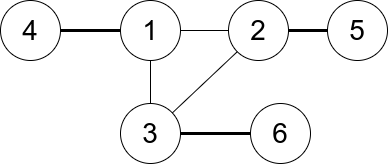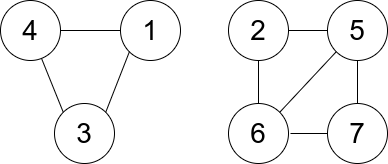Problem
You are given an undirected graph. You are given an integer n which is the number of nodes in the graph and an array edges, where each edges[i] = [ui, vi] indicates that there is an undirected edge between ui and vi.
A connected trio is a set of three nodes where there is an edge between every pair of them.
The degree of a connected trio is the number of edges where one endpoint is in the trio, and the other is not.
Return **the *minimum* degree of a connected trio in the graph, or** -1 if the graph has no connected trios.
Example 1:

Input: n = 6, edges = [[1,2],[1,3],[3,2],[4,1],[5,2],[3,6]]
Output: 3
Explanation: There is exactly one trio, which is [1,2,3]. The edges that form its degree are bolded in the figure above.
Example 2:

Input: n = 7, edges = [[1,3],[4,1],[4,3],[2,5],[5,6],[6,7],[7,5],[2,6]]
Output: 0
Explanation: There are exactly three trios:
1) [1,4,3] with degree 0.
2) [2,5,6] with degree 2.
3) [5,6,7] with degree 2.
Constraints:
2 <= n <= 400edges[i].length == 21 <= edges.length <= n * (n-1) / 21 <= ui, vi <= nui != viThere are no repeated edges.
Solution
class Solution {
public int minTrioDegree(int n, int[][] edges) {
int[] degrees = new int[n + 1];
int[][] adjMatrix = new int[n + 1][n + 1];
for (int[] edge : edges) {
adjMatrix[edge[0]][edge[1]] = 1;
adjMatrix[edge[1]][edge[0]] = 1;
degrees[edge[0]]++;
degrees[edge[1]]++;
}
int minTrios = Integer.MAX_VALUE;
for (int i = 1; i <= n; i++) {
for (int j = i + 1; j <= n; j++) {
if (adjMatrix[i][j] == 0) {
continue;
}
for (int k = j + 1; k <= n; k++) {
if (adjMatrix[j][k] == 0 || adjMatrix[i][k] == 0) {
continue;
}
int trioDegree = degrees[i] + degrees[j] + degrees[k] - 6;
minTrios = Math.min(minTrios, trioDegree);
}
}
}
return minTrios == Integer.MAX_VALUE ? -1 : minTrios;
}
}
Explain:
nope.
Complexity:
- Time complexity : O(n).
- Space complexity : O(n).